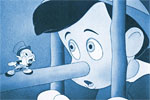Chess Explorations (23)
By Edward Winter

The book whose dust-jacket carried the above commendation was by no means bad,
but would many authors wish their work to be described immoderately? As shown below, there is, in fact, no shortage of them.
The dust-jacket in question was on The Golden Dozen by Irving Chernev.
The book was produced by the Oxford University Press in 1976, and it is rare
to find a reputable publisher resorting to such hype. An occasional co-author
of Chernev’s, Fred Reinfeld, was also the occasional beneficiary (or,
perhaps, victim) of verbal extravagance. As mentioned in C.N. 2377, his book
Chess for Children (New York, 1958) called him a ‘Leading Chess
Master’ and the ‘world-famous chess writer and champion player’.
Only the second of those three claims seems beyond reproach.
The foregoing, however, are by no means the worst cases of hype in chess literature,
as will be seen below. But first, a general caveat may be entered: self-praise
by an author or publisher is not necessarily hype. C.N.
4218 noted that the back cover of Grandmaster Chess Move by Move
by John Nunn (London, 2005) described him as ‘arguably the most highly
acclaimed chess writer in the world’. That is a perfectly reasonable statement.
Downmarket it is a different story. As reported in C.N. 2345, the dust-jacket
of Chess by K.M. Grover and T. Wiswell (London, 1952) stated: ‘Kenneth
M. Grover, when 12 years old, was hailed as a chess child-prodigy, and today
he is America’s number-one chess player.’ The original (1941) US
edition called him ‘America’s Number One chess and checker exhibition
player’. In their other books, Let’s Play Checkers (New York,
1940) and Twentieth Century Checkers (Philadelphia, 1946), the twosome
also awarded themselves high-pitched write-ups. The back-cover of the former
said of Grover: ‘He is America’s No. 1 checker and chess exhibition
star and is popularly known as the “Mighty Mite”.’

From the dust-jacket of the 1941 edition of Chess by Grover and Wiswell
The following appeared on the dust-jacket of The Batsford Chess Encyclopedia
by Nathan Divinsky (London, 1990):

An alternative view to Batsford’s is provided in A
Catastrophic Encyclopedia.
For hype, though, even B.T. Batsford Ltd. of the 1980s and early 1990s has
been shown a clean pair of heels by the US company Cardoza Publishing. It recently
brought out a new edition (supposedly corrected, but not so) of a 2004 book
on Fischer by Eric Schiller. The back cover asserts that he (Schiller, not Fischer)
is ‘widely considered one of the world’s foremost chess analysts,
writers, and teachers’. As shown in our review of World
Champion Combinations, those same words were already being used by Cardoza
over a decade ago. An alternative view as to what Eric Schiller may be ‘widely
considered’ is provided in A Sorry Case and
Copying.
His co-author for World Champion Combinations was Raymond Keene, and
opposite the title page was a claim that he is ‘considered one of the
strongest players in the world’. The considerers were naturally not named
because, as pointed out in our above-mentioned feature article on the book,
he played his last serious chess in the mid-1980s, and on the 1986 rating list
he was not among the top ten players in England, let alone the world.
Many of his books contain material relevant to the present article, but just
one further example will be given for the time being: the dust-jacket of Samurai
Chess by Michael Gelb and Raymond Keene (London, 1997) described the latter
as ‘the world’s leading authority on chess and mindsports. An International
Chess Grandmaster since 1976 and winner of 14 separate British championship titles ...’ Tony Miles’ assessment of the book was published on pages 52-53 of the Spring 1998 Kingpin. More generally, Kingpin has also published this
unmissable article.
Submit information
or suggestions on chess explorations
All ChessBase articles
by Edward Winter
 Edward
Winter is the editor of Chess
Notes, which was founded in January 1982 as "a forum for aficionados
to discuss all matters relating to the Royal Pastime". Since then, over 6,200
items have been published, and the series has resulted in four books by Winter:
Chess
Explorations (1996), Kings,
Commoners and Knaves (1999), A
Chess Omnibus (2003) and Chess
Facts and Fables (2006). He is also the author of a monograph
on Capablanca (1989).
Edward
Winter is the editor of Chess
Notes, which was founded in January 1982 as "a forum for aficionados
to discuss all matters relating to the Royal Pastime". Since then, over 6,200
items have been published, and the series has resulted in four books by Winter:
Chess
Explorations (1996), Kings,
Commoners and Knaves (1999), A
Chess Omnibus (2003) and Chess
Facts and Fables (2006). He is also the author of a monograph
on Capablanca (1989).
Chess Notes is well known for its historical research, and anyone browsing
in its archives
will find a wealth of unknown games, accounts of historical mysteries, quotes
and quips, and other material of every kind imaginable. Correspondents from
around the world contribute items, and they include not only "ordinary readers"
but also some eminent historians – and, indeed, some eminent masters. Chess
Notes is located at the Chess
History Center. Signed copies of Edward Winter's publications are
currently available.





















 Edward
Winter is the editor of
Edward
Winter is the editor of 




